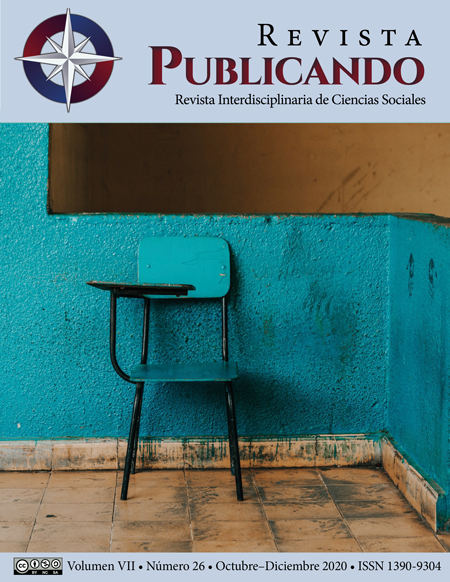Abstract
The article tries to provide an understanding of the intercultural processes of the Quijos nationality from the point of view of the social actors themselves. This analysis seeks to understand the intercultural conformation of the Quijos nation from a worldview that provides elements to speak of an Amazonian philosophy that does not disassociate the relationship between nature and culture. It starts from the bibliographic analysis and the recovery of historicity, that is, the history told from below, from those who live it, because one is the history told by the “winners” and the other by he “defeated”. As we delve into the cultural features of the Quijos, we will take its territorial delimitation as a starting point and then we will remember how it was influenced by other human groups with different interests. It must be considered that this work aims to analyze the sociocultural processes of the Quijos nation. In methodological terms, the starting point are the life stories, historicity and the practices of ceremonies and rituals that give way to the cosmos and self-determination are recovered. In conclusion, a contribution is generated to be able to speak of an Amazonian philosophy, revealing the socio-historical processes of exploitation of the territory, as well as the cultural imposition on human groups that inhabit the Amazon.
References
Asamblea Nacional de la República del Ecuador. (2008). Constitución república del Ecuador. Quito: Asamblea Nacional de la República del Ecuador.
Bauman, Z. (2002). La cultura como praxis. Madrid: Paidós.
Bertaux. (1979). Escritura de sociología: Información sobre las Ciencias Cociales, 19, pp. 7-25.
Catani, M, Mazé, S, y Tante, S. (1982). Una historia de vida social. París: Librería Meridians.
De la Cuadra, J. (1960). El montuvio ecuatoriano. Quito: Libresa.
Dussel, E. (1996). Filosofía de la Liberación. Bogotá: Nueva América.
Dussel, E. (2016). Filosofías del Sur. Descolonización y Transmodernidad. México: Aditorial Akal.
Estrada, M. (1997). “La Experiencia de los Sectores populares Urbanos”. Infancia y Trabajo. Centro de Investigaciones y Estudios Superiores en Antropología Social, México.
Esvertit, N. (2001). Los imaginarios tradicionales sobre el oriente ecuatoriano. Revista de indias, vol. LXI (223), p. 541-571.
González, S. (1903). Historia general de la República del Ecuador. Quito: Imprenta del Clero. Recuperado de htpp://www.cervantesvirtual.com.
Guevara, D. (2010). Nuestros genes Quijos. Ecuador.
Ibarra C., H. (1992). La identidad devaluada de los "Modern Indians". En D. Cornejo Menacho (Ed.), Una reflexión sobre el levantamiento indígena de 1990 (pp. 319-349). Quito: ILDIS y ABYA-YALA.
Jaramillo, P. (2006). El indio ecuatoriano. Quito: Universidad Alfredo Pérez Guerrero.
Kornblit, A. (2004). “Modelos y procedimientos de Análisis”, Metodologías cualitativas en ciencias sociales. ISBN 950-786-415-6, Buenos Aires.
Landázuri, C. (1989). La gobernación de los Quijos (1959-1621). Quito: Instituto de Historia y Antropología Andina.
Levinas, E. (1977). Totalidad e infinito. Salamanca: Sígueme.
Mallimaci, F, y Giménez, V. (2006). “Historias de vida y método biográfico”, Estrategias de Investigación Cualitativa, Barcelona, Gedisa.
Muratorio, B. (1982). Etnicidad, evangelización y protesta en el Ecuador: una perspectiva antropológica. Quito: CIESE.
Muratorio, B. (1985). Rucuyaya Alonso y la Historia Social y Económica del alto Napo 1850 – 1950. Quito: Abya Yala.
Oberem, U. (1980). Los Quijos. Historia de la transculturación de un grupo indígena en el Oriente ecuatoriano. Otavalo: Instituto Otavaleño de Antropología.
Porras, P. (1985). Arte rupestre del Alto Napo-Valle de Misaguallí. Quito: Artes Gráficas.
Ricoeur, P. (2006). Sí mismo como otro. Madrid: Siglo XXI.
Real Academia Española (2019). Diccionario de la lengua española. España: La Caixa. Recuperado de: https://dle.rae.es/identidad
Rubio, G. (1976). “Políticas y Estrategias en el Indigenismo de América”, en América Indígena, vol. XXXVI (3).
Ruiz, L. (1992). “Jumandi. Revelión, anticolonialismo y mesianismo en el oriente ecuatoriano, siglo XVI”, en Fernando Santos. Opresión colonial y resistencia indígena en la alta Amazonía. Quito: FLACSO.
Sautu, R. (1999). “El método biográfico”, Buenos Aires, Editorial Belgrano.
Uzendoski, M. (2005). The Napo Runa of Amazonian Ecuador. University of Illinois Press, Urbana.

This work is licensed under a Creative Commons Attribution-NonCommercial-ShareAlike 4.0 International License.
Copyright (c) 2020 Fredy Aguilar Rodríguez, Anita Espín Miniguano, Roberto Alvarado Quinto


